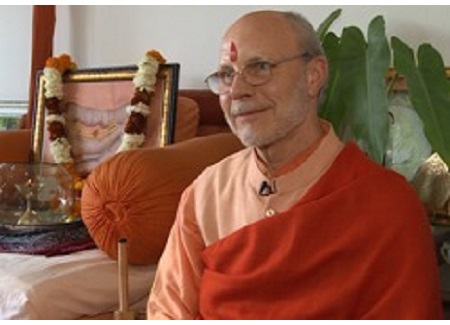
“Vasudeva, the Indwelling-Lord” Annual Festival of Spiritual Peace by Swami Ritavan Bharati – June 18 – July 27 2018
Annual Festival of Spiritual Peace
by Swami Ritavan Bharati
18th June till 27th July 2018
“Vasudeva, the Indwelling-Lord”
Through the living presence of Swami Veda here in Sadhaka Grama, we are inspired to return “home” to the theme of “Vasudeva”. This theme holds many gems of sadhana practiced as the Annual 40-Day Festival of Spiritual Peace.
For 2018, our theme of “Vasudeva” will focus on three kriyas [practices]: ahimsa, aparigraha, and Ishwara-pranidhana.
Please see the edited talk below by Swami Veda addressing these, plus the links and references given for details on the observances during the Festival. Enjoy this immersion in sadhana during the festival celebration of Spiritual Peace.
— Swami Ritavan Bharat
Vasudeva Principle
by Swami Veda Bharati
In the Bhagavad Gita, we read “vasudeva sarvam”. That indwelling One is All. There is no other in relation-to, or conditioned-by. What do we mean by the indweller, the indwelling force? One of the many ways, the word “vasudeva” is translated in Bhagavad Gita is the “indwelling deity”. This is closely related to the word “vasu”, meaning, “all places”, for all places are dwelling places of divinity. Vasu is also the “hamsa”, that swan of the universal prana dwelling every-where in every-thing. Vasu-mana is also one of the thousand names of Shiva in the Mahabharata. Vasu-mana means beautiful mind, a mind that dwells as light in Being, and therefore, Vasu is the beautiful, light-filled, indwelling force.
May your mind be vasu-mana. Not this “me”, this little individuated mind, but mind as it is linked to the minds of the whole universe. When one mind-wave meets another mind-wave and a continuum is experienced that is called “mind as an energy field”. One mind-wave meeting another mind-wave in this oceanic-wave-field, and the two become one. When your individual mind touches that universal mind, “samasthi-chitta”, the senses of time and space dissolve. There is a force that acts through the force-field called “mind”, where space and time cease and some other force flows.
The practical application of that is in the principle called ahimsa. Until you learn to practice ahimsa you will never understand what cosmic mind is. You will not understand without the practice of non-violence, because according to the tradition, when you are hurting someone, being angry at someone, you are hurting and harming yourself. Each time people hurt themselves they express any form of violation, and this extends up to the entire cosmic mind, that cosmic mind of which you are a part. That is why among the yamas and niyamas the first yama is ahimsa.
What is ahimsa? First, you should know the Sanskrit word, “Sarvata”, meaning in all possible ways, in all possible modes. Of the many names for God, one of Her names is Sarvam, “All”. That All is indivisible, without division, not divided. Among all the divisions we experience, the “All” – Sarvam, remains full, undivided, complete in Her nature, and that is your true nature.
Ahimsa is associated with words, with thoughts, with actions. Doing it yourself, causing someone else to do it, someone else committing a violent act and you consent to it with words or silently. “Sarvata,” means at all times, in all ways, there is the intention to hurt, harm or injure. Not having the intention to hurt is ahimsa.
Of these 10 yamas and niyamas, after ahimsa, the remaining nine: satya, asteya, brahmacharya, aparigraha, saucha, santosha, tapas, swadhyaya, ishwara-pranidhana are all rooted in the first, ahimsa. They are there to help accomplish the perfection of ahimsa. They simply describe some aspect of ahimsa, and to make ahimsa perfect the other nine are included and necessary.
So if you want your prayers, your meditations, your silence, leading to your serenity, your quest for serenity, leading to your quest for peace of mind, yet, all the time you are committing himsa, all the time you are committing violence with your mind, where will your peace of mind be? For this reason, I am suggesting that you apply these kriyas, these applications of your yoga beginning with ahimsa and next, aparigraha.
This second practice (kriya) is aparigraha, non-attachment, not grasping or holding, possessing one’s object of desire beyond the “need” for which it fulfills. It is because of your lack of aparigraha that so much himsa is taking place and collection destruction of species is happening. Scale down your desires, and learn to remove your attachments to practice aparigraha. Take less, and let-go more. Keep to your practice of aparigraha and ahimsa.
These two, ahimsa and aparigraha are two closely related, but I want you to now add, Ishwara-pranidhana. What is the in-dwelling spirit – Ishwara in the butterfly? What about the Ishwara in the ocean or rivers that you have filled with plastic or muck? And when you take a shower or wash your hands remember the water you are using is now reduced, less for others. Be conscious, be aware, aware you are committing indirect violence. In many of your actions you are committing violence. Learn to enjoy more of less, and the world will be saved. These are all interlinked, the Ishwara pradhidhyana and your aparigraha and ahimsa are all linked. In this way, the amount of water you are using will reveal an understanding of Isha, the One Lord, practicing the presence of God, Ishwara pradhidhyana.
Practicing these kriyas will provide an “attitude-adjustment,” and thereby with a purified mind, you will experience a quietness and a sense of satisfaction. This mental-pacification is the essence of spirituality, this is the essence of dharma, this is the teaching that will elevate you and alleviate so many burdens of your mind.
Another part of Ishwara-pranidhana is “surrender to the Lord.” This indwelling principle, the indwelling Lord is Ishwara. Ishwara is that aspect of God which in relationship with the universe and its beings. And, Dhyana means to surrender, to merge your individual mind into the universal mind consciousness. Your individuated ego into the divine presence. Learn to connect with the lineage with Guru Parampara and at that moment the Guru Parampara lifts you and carries you.
When a Guru, yogishwara, divine Lord, Ishwara, graces you with attention, that is called Ishwara pranidhana. The devotee’s dhana is responding to by the divine (Ishwara) pranidhana. You will understand that only when you experience that connection through Samashti-chitta and through the Ishwara pranidhana principle, the Mahabharata explains, You only have to remember him.
Whatever I say, please go home and examine your life, examine your choices in life. Plan your spiritual life as you plan your worldly life. You plan for your finances, you plan for your business, you plan for what kind of house you will buy, you plan for what kind of car you will buy, you plan for what kind school you will send your kids to, you plan what kind of clothes you will buy for Christmas or Diwali, plan for your spiritual life.
You plan for insurance. Plan how much japa you will finish in five years. Plan for how much you will reduce your direct or indirect violence in the next five years or in the next one year. Plan that. Plan for how you can increase the time you sit for your prayers and your meditation. You will make a difference. Take it seriously. Plan for the moment of dying. Plan for the kind of body you want next time. Plan for in what kind of a household you want to be born next time. Part of that plan is the mood of your dying, what mood, what sentiment, what feeling, what smile there will be on your face at the moment of dying. What satisfaction you will have with your last breath.
Plan now for what spiritual improvements you will make in the next 40-days, in the next one year, in the next five years. If you need help we can help. (Send comments or questions to: Dear Yoga Mentors, My Question is…)
Enjoy the meditations on the full moon day each and every month. Slowly, slowly something will happen for you. So that is the indwelling principle, Vasudeva.
(See meditation on Vasudeva.)
Links and References:






